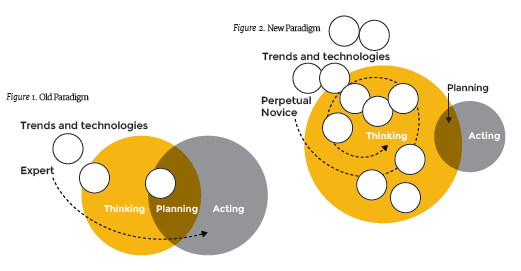Unfortunately, simply knowing what the cause of this acceleration is does not make it any less astonishing — or easier to deal with. In fact, we would argue that the dizzying pace of change in our field poses the greatest single threat to its health. This paper is about this threat — and what you can do to minimize it.
Three scientists were awarded the Nobel Prize in physics for discovering something extraordinary. While conducting observations on the universe, they confirmed that it was indeed expanding, as had been theorized, but (to their astonishment) at an accelerating rate. Unable to determine why, they attributed this phenomenon to a previously unknown force called dark energy.
Like the universe, modern marketing is also expanding at an accelerating rate. In this case, however, the force behind it is no mystery — it’s technology.
Perpetual novice syndrome
Think about it. From the moment you hear about a new tool, technology or trend, the clock starts running. As marketers, we’re expected to figure out what it is, evaluate its appropriateness for our organizations, vet competitive solutions, integrate it with our IT infrastructure, begin executing it flawlessly and stand ready to prove why it is such a great investment. Oh, and could you have that on my desk by Monday morning?
 Multiply this by the seemingly daily emergence of new applications of technology and concepts (all of which promise to be game-changing), and you have something akin to “paralysis through analysis.” Instead of the field of marketing being comprised of people who have had time to develop expertise and judiciously act on their knowledge [figure 1], it is increasingly populated by perpetual novices — people so busy trying to learn the next new thing that they can’t master anything [figure 2].
Multiply this by the seemingly daily emergence of new applications of technology and concepts (all of which promise to be game-changing), and you have something akin to “paralysis through analysis.” Instead of the field of marketing being comprised of people who have had time to develop expertise and judiciously act on their knowledge [figure 1], it is increasingly populated by perpetual novices — people so busy trying to learn the next new thing that they can’t master anything [figure 2].
While this predicament hasn’t yet been given significant attention, we believe there is tacit recognition of its existence. Take, for example, this recent debate motion found on the Economist website:
“Are there better ways to manage the vast amounts of information assaulting users on a daily basis? What is the right balance between new tools and information streams, on the one hand, and minimizing the impact of information overload on the other? Are people losing their ability to reflect rather than just react?”
From what we’ve seen, most marketers are trying to cope with the breakneck pace of change by simply running faster. Yet, the net effect of this is a loss of marketing effectiveness. Why?
- It’s exhausting – for you and your team
- It creates an environment that is reactive, not strategic
- It prevents you from connecting the dots
While the first two are bad enough, this last point is especially insidious. Mayur Gupta, Global Head of Marketing Technology for Kimberly-Clark, describes it this way: “I think many marketing organizations are sucking things in like a vacuum — a tendency to pick up every shiny object out there. Big data, mobile first, predictive modeling, and so on. The challenge is a lack of connected thinking that brings all these different pieces together in a cohesive and well-knit machinery.”
The answer: positive adaptation
So what can be done? Clearly, the answer is not taking things slower — everyone from our customers to the C-suite simply will not allow that. Perhaps you can wait it out? After all, the rapid rate of change could be an “acute” rather than a “chronic” condition of the current environment. If it is the former, the rate of innovation will return in the near future to a more manageable pace. That’s a bad bet to take. What we believe to be far more likely is that a constant state of disruption is the “new norm.” If that is the case, an entirely different type of behavioral approach will be needed to thrive in such an environment.
Take, for example, Big Data, a trend that is certainly top-of-mind for all marketers. As a recent IBM survey quoted one CMO (echoing the sentiments of most), “At this moment, I don’t know how our marketing department will cope with the expected data explosion.” This is understandable — the volume and variety of data available today is staggering. Yet, perhaps the data itself is not the problem — it’s how companies are approaching it. A recent study by the CMO Council and SAS found a lack of CMO/CIO alignment, rigid silos, unclear responsibilities and a lack of leadership all impeding organizations from using Big Data to its full potential. The cause of the problem in this case, then, is not the “Bigness” of the data, but rather, the “Bigness” of the organizational barriers to dealing with it.
These organizational barriers are often the product of individual behaviors. As we have already suggested, how employees gain job knowledge and how they use that knowledge to make accurate judgments on the job can be compromised by the perpetual novice syndrome.
We would argue that the cycle that leads to being a perpetual novice is one of maladaptation — the accumulation of behaviors that, while reasonable at one time, have become more of a hindrance as change accelerates around us.
The dilemma we’ve described may seem intractable on its face — the world will not slow down and apparently, we cannot speed up enough to catch it. In light of this, the only real answer is to heighten our ability to deal with hyper-change by perceptually slowing IT DOWN to a conceivable rate — think Neo IN THE MATRIX, adroitly dodging bullets. There are several strategies that come to mind that, in combination, would prove valuable in doing this:
Accepting accelerated change
According to Buddhist belief, because all things are constantly in a state of flux, attachment to them becomes a cause for future suffering. And so it is with what we think we know about marketing. Don’t get bogged down in the way you used to do things — three- to five-year high-level marketing plans, divided into 12-month sections and based on strict schedules. Such approaches may have worked well in the past, but they are far too rigid for today. Programs can have broad contours, but it’s better to think in terms of weeks — not years. Also, forget about having perfect information before you act. Today, such perfection comes with a high price — prospects that are sucked up by aggressive competitors, or the loss of coveted “first-mover” status. Besides, as Malcolm Gladwell has noted, there are times “when our snap judgments and first impressions can offer a much better means of making sense of the world.”
Decoding accelerated change
To avoid being spotted by an enemy, military aircraft can spread a cloud of small, thin pieces of aluminum called chaff, which either appears as a cluster of secondary targets on a radar screen or swamps the screen entirely. Companies today must be able to see which new trends and technologies should be targeted by their organizations and which are “marketing chaff.” Do you have a process for identifying salience (e.g., appropriateness to your organization) of oncoming change? A simple “gut check” may have sufficed at one time, but something more formal is in order now. Try developing strategic filters with which to review new trends and technology — long-term impact vs. short-term impact, highly aligned with business strategy vs. less aligned, etc. The better your vetting process, the more focused you can be on what matters most.
Processing accelerated change
A distinction needs to be drawn between information marketers get bombarded with everyday and information they should actually use. In fact, the processing overload that fuels perceptual novice syndrome can, in many cases, be viewed as “skeptical underload” — the problem is not so much the speed and volume of information, but our difficulty discerning bias in that information if we are not authorities on a certain subject. In an era of accelerated change, it is critical to not lose your “North Star” — the precepts that govern good marketing. These should serve as a litmus test when you are engulfed in the hype of a new tool, social media gateway or methodology. Yes, look closely at harnessing the advantages of the next new thing, but always keep one eye on the fundamentals. For example, no matter how cool thing “x” seems, you ultimately need to build trust-based relationships with your customers. Will it help you do that?
ultimately need to build trust-based relationships with your customers. Will it help you do that?
The emergence of more and more sophisticated tools, technologies and channels separated by shorter and shorter time intervals is not something we can control.
What we can control is how well we adapt to such an environment. Increasingly, this will be the key determinant of whether we realize a positive return on acceleration.
Movéo is a demand generation agency uniquely built to help its clients measurably improve business performance. We focus on three interdependent drivers of growth — branding, lead generation, and customer acquisition — to attract, secure, and retain customers for our clients.
Download



